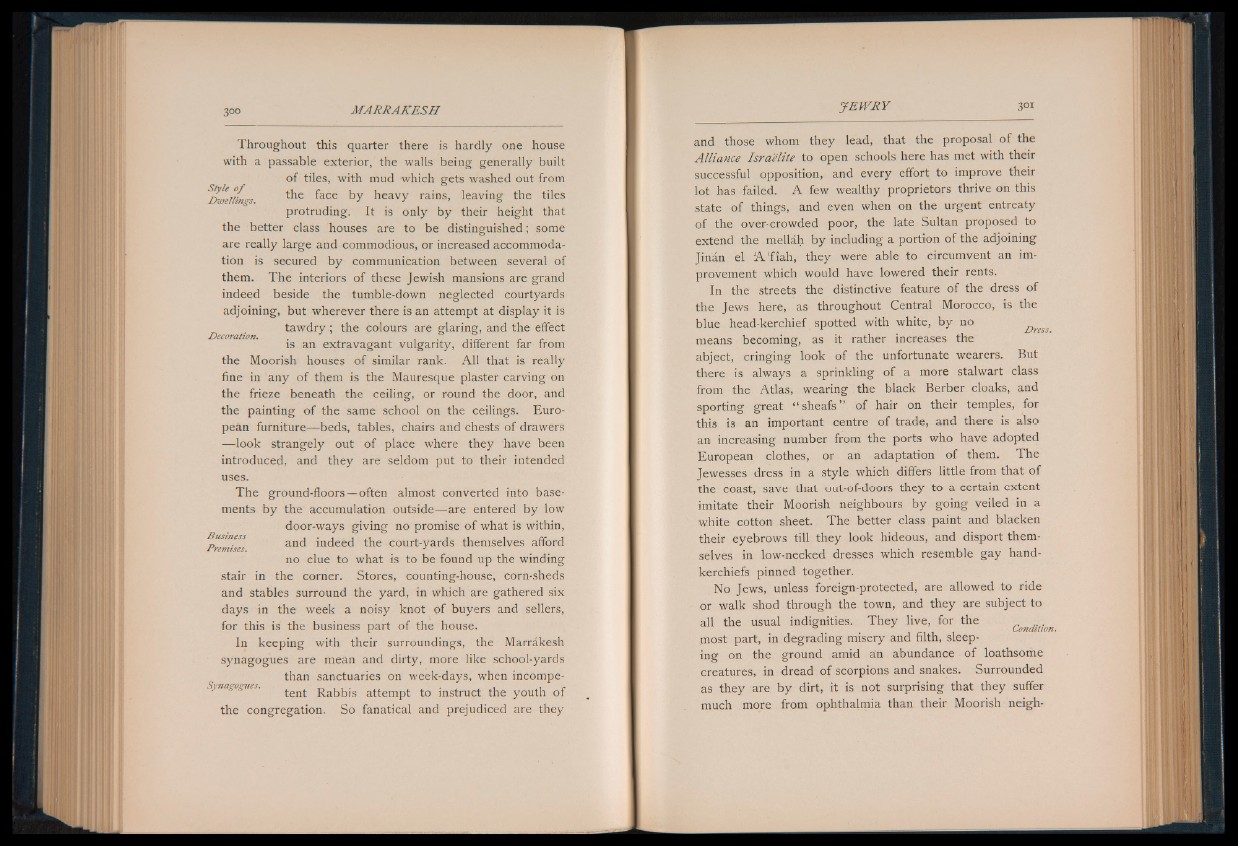
Throughout this quarter there is hardly one house
with a passable exterior, the walls being generally built
of tiles, with mud which gets washed out from
Stvl o f
Dwellings t^ie ^ace by heavy rains, leaving the tiles
protruding. It is only by their height that
the better class houses are to be distinguished; some
are really large and commodious, or increased accommodation
is secured by communication between several of
them. The interiors of these Jewish mansions are grand
indeed beside the tumble-down neglected courtyards
adjoining, but wherever there is an attempt at display it is
taw d ry ; the colours are glaring, and the effect
Decoration. . J ° HI H 1
is an extravagant vulgarity, different far from
the Moorish houses of similar rank. All that is really
fine in any of them is the Mauresque plaster carving on
the frieze beneath the ceiling, or round the door, and
the painting o f the same school on the ceilings. European
furniture— beds, tables, chairs and chests of drawers
.— look strangely out of place where they have been
introduced, and they are seldom put to their intended
uses.
The ground-floors — often almost converted into basements
by the accumulation outside— are entered by low
door-ways giving no promise of what is within,
„ . and indeed the court-yards Premises. J themselves afford
no clue to what is to be found up the winding
stair in the corner. Stores, counting-house, corn-sheds
and stables surround the yard, in which are gathered six
days in the week a noisy knot pf buyers and sellers,
for this is the business part of the house.
In keeping with their surroundings, the Marrakesh
synagogues are mean and dirty, more like school-yards
than sanctuaries on week-days, when incompe-
Synagogues. , . . . , , r
tent Rabbis attempt to instruct the youth of
the congregation. So fanatical and prejudiced are they
and those whom they lead, that the proposal o f the
Alliance Israélite to open schools here has met with their
successful opposition, and every effort to improve their
lot has failed. A few wealthy proprietors thrive on this
state of things, and even when on the urgent entreaty
of the over-crowded poor, the late Sultan proposed to
extend the mellâh by including a portion of the adjoining
Jinan el A 'fiah , they were able to circumvent an improvement
which would have lowered their rents.
In the streets the distinctive feature of the dress of
the Jews here, as throughout Central Morocco, is the
blue head-kerchief spotted with white, by no
means becoming, as it rather increases the
abject, cringing look of the unfortunate wearers. But
there is always a sprinkling of a more stalwart class
from the Atlas, wearing the black Berber cloaks, and
sporting great “ sheafs” of hair on their temples, for
this is an important centre of trade, and there is also
an increasing number from the ports who have adopted
European clothes, or an adaptation of them. The
Jewesses dress in a style which differs little from that of
the coast, save that out-of-doors they to a certain extent
imitate their Moorish neighbours by going veiled in a
white cotton sheet. The better class paint and blacken
their eyebrows till they look hideous, and disport themselves
in low-necked dresses which resemble gay handkerchiefs
pinned together.
No Jews, unless foreign-protected, are allowed to ride
or walk shod through the town, and they are subject to
all the usual indignities. They live, for the . M Condition.
most part, in degrading misery and filth, sleeping
on the ground amid a:n abundance of loathsome
creatures, in dread of scorpions and snakes. Surrounded
as they are by dirt, it is not surprising that they suffer
much more from ophthalmia than their Moorish neigh